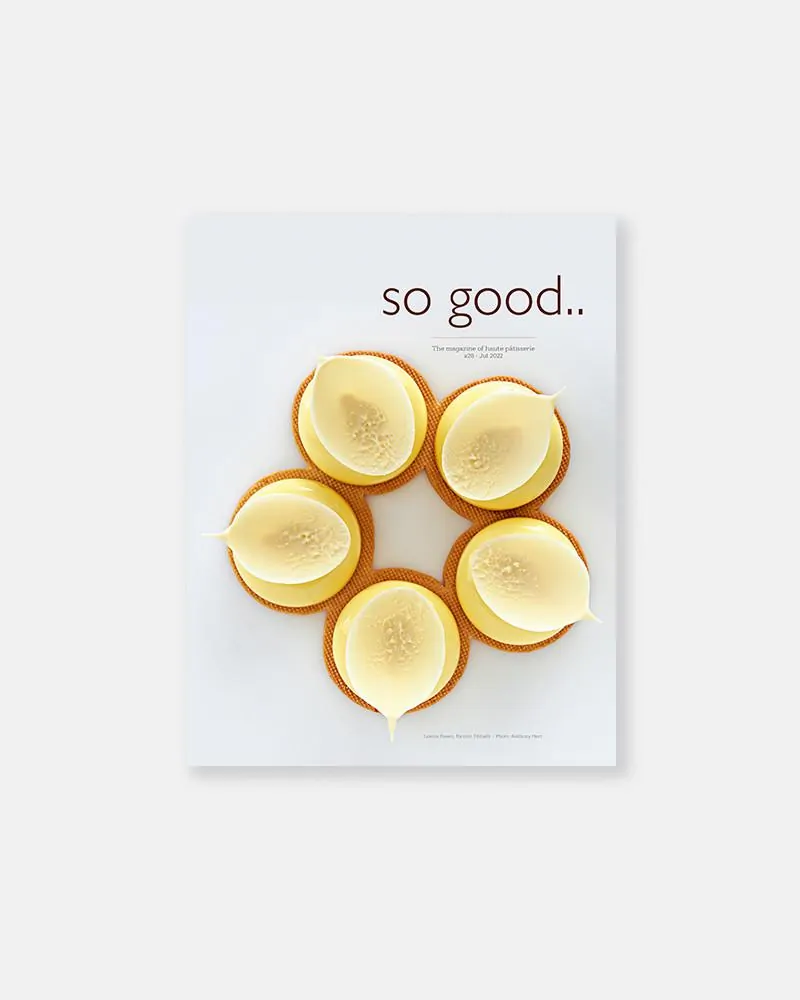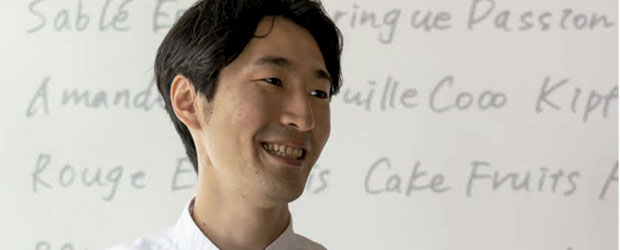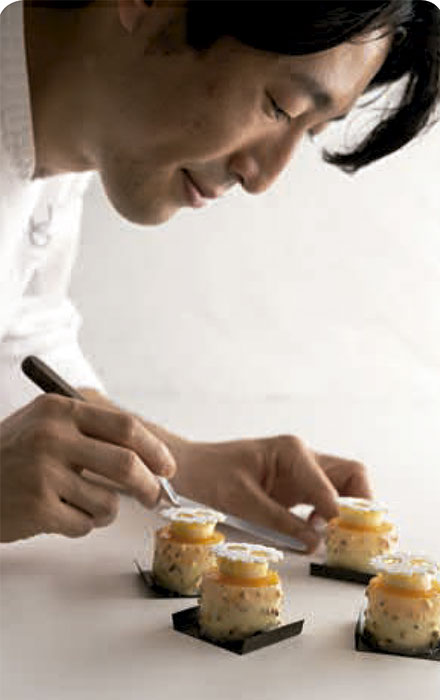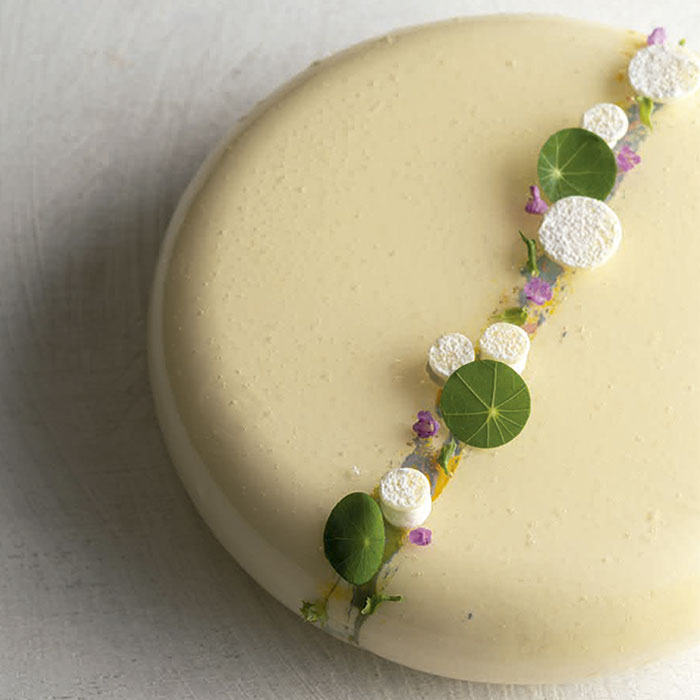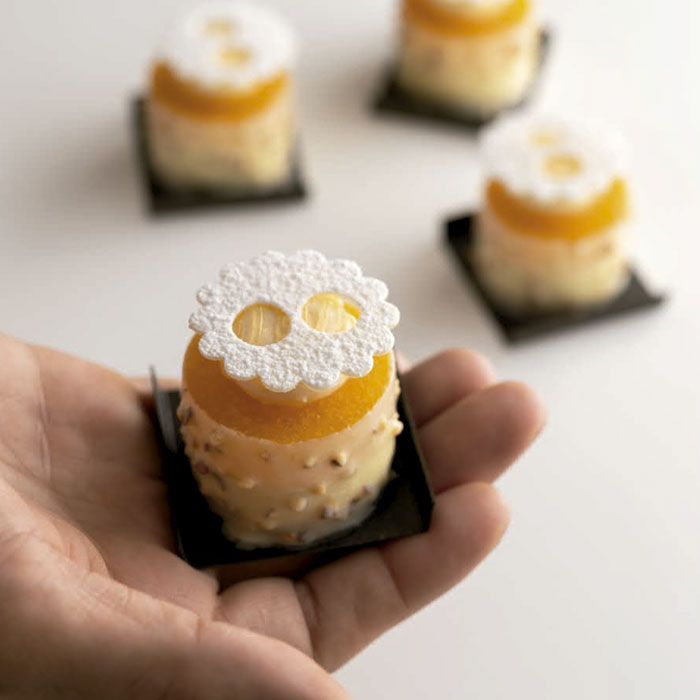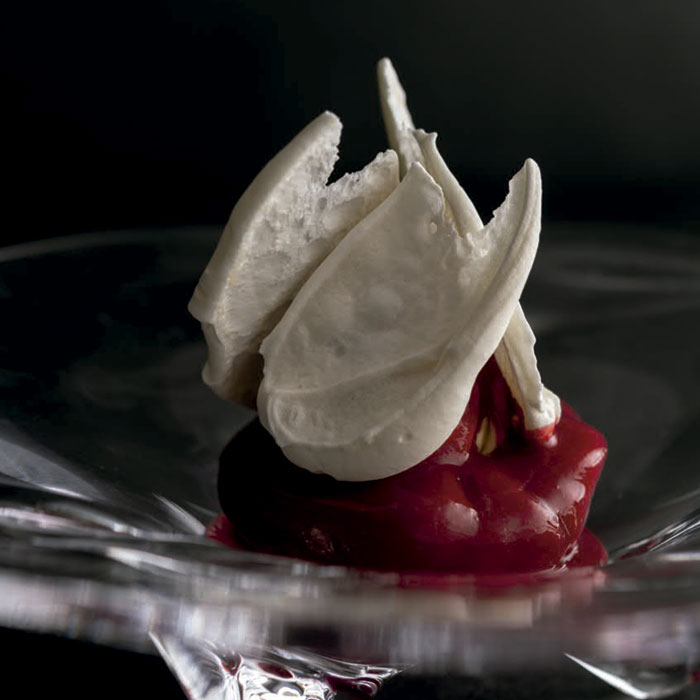Categories Pastry Chef Articles
Tomonari Kombu. The beauty of empty space
Japanese Pastry Chefs Pastry Interviews so good #28 Tomonari Kombu
Author:
Reiko Matsuno
TAGS #
Japanese Pastry Chefs Pastry Interviews so good #28 Tomonari Kombu
He posts entremets almost daily on his Instagram. He says, “Since I started posting every day, my followers have increased rapidly”. Of course, Chef Tomonari Kombu is not making cakes of different colors, designs, and textures every day to increase his followers. The initial ideas are from customers’ requests, which would pass through his creative filter. ‘Our customers ask me things like, ‘I want the cake full of flowers,’ ‘make it simply cute,’ or ‘I’d love to see a cake in that popular anime kind of view of the world.’ My job is to understand my customers’ wishes and translate them in my way,’ says Kombu at so good #28.
Photos: Haruko Amagata
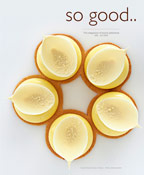
He has been a chef at the Un Grain in Aoyama, Tokyo, for three years, which was opened seven years ago by a major confectionery manufacturer. It is Japan’s, and possibly the world’s, only pastry shop specializing in mignardises. The 4 cm-wide and 4 cm-high cakes are even smaller than a petit gâteau and can be ruined if the amount of ingredients is changed by 1 g, or the baking temperature is higher by 1ºC.
The range of about 20 varieties is changed seasonally except for two regular cakes. The ‘Lunettes’ he presented for So good.. magazine is his specialty using Ougon no Ume (golden ume apricot), grown in his hometown in the Fukui prefecture. It has an aromatic flavor like apricots or peaches but a strong sourness unique to ume apricots. To ease the sourness and create balance and harmony, he combines it with white chocolate, mascarpone, and maple syrup. Why is it called glasses? It is because Fukui Prefecture is not only a source of Ougon no Ume or seafood that is highly appreciated by Kyoto’s ryotei restaurants but also Japan’s largest producer of eyeglasses.
Kombu was born in a wagashi (Japanese confectionery) shop in Fukui. During his college years in Tokyo, he came across the famous patisserie ‘Au Bon Vieux Temps’. He was so taken aback by the rich taste of the French cakes, which were different from those of western pastry shops in Japan he was used to. ‘I was so intrigued by cakes with intense flavors and liqueur that I decided to work here!’ And he kept his promise to himself. He spent his 20s working there and at the Pierre Hermé as sous chef afterward. It was not until his 30s that he went to France to study. ‘People would think studying abroad in one’s 30s is a bit late for a pâtissier, but I went there rather to experience firsthand the environment, culture, and atmosphere where the cakes I admired were born. I had already accumulated skills and knowledge, so co-workers trusted me or depended on me. During the days in Paris, I had great opportunities to meet inspiring friends, which is the most valuable asset for me today.’
“People would think studying abroad in one’s 30s is a bit late for a pâtissier, but I went there rather to experience firsthand the environment, culture, and atmosphere where the cakes I admired were born”
The occupations of these friends were different, but they had high motivations and ambitions in common. And they are working successfully back in Japan as chefs, fashion designers, florists, etc. Because of the friendship, the scope of Kombu’s activities is no longer limited to the pastry shop. Not only does he create creative entremets at the request of customers, but he is often asked to collaborate with people from other industries. He has created cakes to match the clothing of a designer he met in France, paired confections with single-origin coffee for a coffee shop and made a white beer granite for an event with a bartender. In May, he made the aroma-theme dessert courses collaborating with Chef Mineko Kato, who was named Asia’s Best Pastry Chef 2022. The collaboration between Kato, who belongs to an Italian restaurant managed by a major cosmetics company, and Kombu, working under Japan’s leading confectionery manufacturers, is a sign that the winds of open innovation are blowing in the pastry industry as well.
‘As I work for a well-known confectionery company, it’s easier to challenge things. I would like to collaborate with people beyond the boundaries of food genres to convey the joy of eating to as many people as possible.’ It’s not surprising that he jumps into the store and asks the manager to talk about the collaboration when he finds something very appealing. Not long ago, it was the new collection of Iittala tableware.
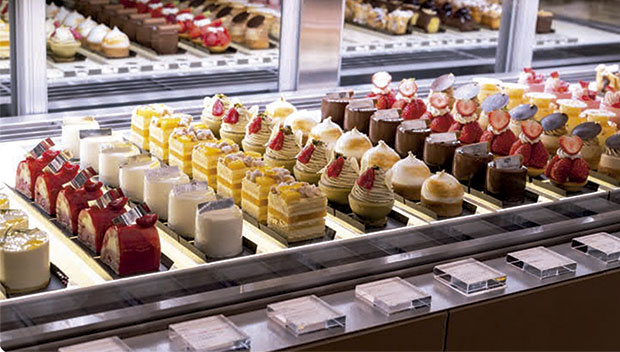
“Now that I am in my 40s, I have a greater sense of the good qualities of Japan, and perhaps because of this, I am pursuing the beauty of empty spaces or clearing the clutters, which I think is unique to Japan”
He asked them to work together and managed to serve his dessert on Iittala’s plates at Un Grain. Now, he almost regularly collaborates with ceramic artists and other artists so that customers can enjoy his desserts with the dishes that catch his eye from time to time.
His time as an apprentice in France, where he observed colorful and gorgeous French cakes, was also a time for him to reevaluate the good qualities of Japan. ‘Now that I am in my 40s, I have a greater sense of the good qualities of Japan, and perhaps because of this, I am pursuing the beauty of empty spaces or clearing the clutters, which I think is unique to Japan.’ He wanted to express Japanese aesthetics in the entremets he created for So good.. magazine this time, using ingredients often used in Japanese confections. He chose Shiro An or sweetened white bean paste and matcha as the main ingredients and added herbal flavors of anise and dill to bridge the ‘grassy’ aroma of matcha and the white bean paste. For this cake, white chocolate, which is often avoided in sophisticated cakes because it is ‘too sweet’, is infused with cacao nibs to emphasize the aroma of the cacao. As for the decoration, he depicted the beauty of Japan with tiny white chocolate elements and green and yellow lines flowing like Japanese calligraphy across the cake.
While always paying homage to the traditions of French pastry handed down from generation to generation, Kombu’s world is being updated daily by integrating his Japanese identity and inspiration from other industries.
